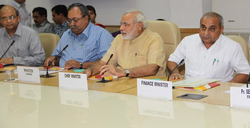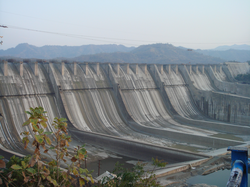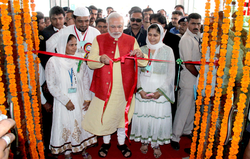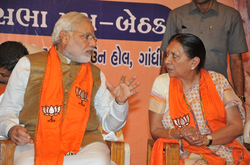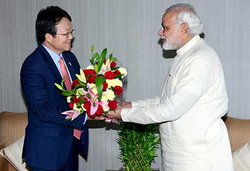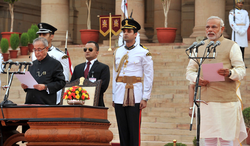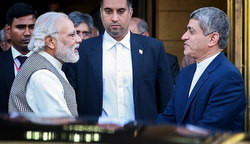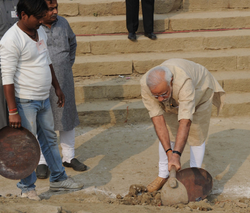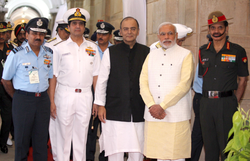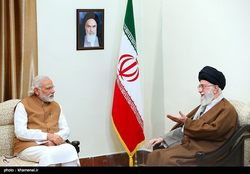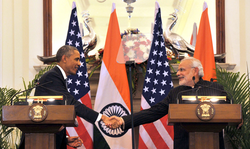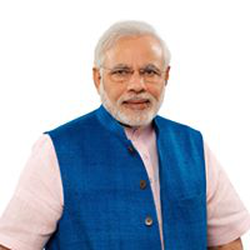Narendra Modi
Narendra Modi
| Narendra Modi | |
|---|---|
| 14th Prime Minister of India | |
**Incumbent ** | |
| Assumed office26 May 2014 | |
| President | Pranab Mukherjee Ram Nath Kovind |
| Preceded by | Manmohan Singh |
| Chief Minister of Gujarat | |
| In office7 October 2001 – 22 May 2014 | |
| Governor | Sunder Singh Bhandari Kailashpati Mishra Balram Jakhar Nawal Kishore Sharma S. C. Jamir Kamla Beniwal |
| Preceded by | Keshubhai Patel |
| Succeeded by | Anandiben Patel |
| Member of the Lok Sabha for Varanasi | |
**Incumbent ** | |
| Assumed office16 May 2014 | |
| Preceded by | Murli Manohar Joshi |
| Member of the Gujarat Legislative Assembly for Maninagar | |
| In office1 January 2002 – 16 May 2014 | |
| Preceded by | Kamlesh Patel |
| Succeeded by | Suresh Patel |
| Personal details | |
| Born | Narendra Damodardas Modi(1950-09-17)17 September 1950(age 67)Vadnagar, Bombay Presidency now Gujarat, India |
| Political party | Bharatiya Janata Party |
| Spouse(s) | Jashodaben(m. |
| Residence | 7, Lok Kalyan Marg |
| Alma mater | University of Delhi Gujarat University |
| Signature | [[INLINE_IMAGE|https://upload.wikimedia.org/wikipedia/commons/thumb/8/80/Signature_of_Narendra_Modi_(Hindi).svg/128px-Signature_of_Narendra_Modi_(Hindi).svg.png|||h51|w128]] |
| Website | Official websiteGovernment website |
Narendra Damodardas Modi ( Gujarati: [ˈnəɾeːnd̪rə d̪aːmoːd̪əɾˈd̪aːs ˈmoːd̪iː] ( ), born 17 September 1950) is an Indian politician who is the 14th and current Prime Minister of India, in office since May 2014. He was the Chief Minister of Gujarat from 2001 to 2014, and is the Member of Parliament for Varanasi. Modi, a member of the Bharatiya Janata Party (BJP), is a Hindu nationalist and member of the right-wing Rashtriya Swayamsevak Sangh (RSS).
Born to a Gujarati family in Vadnagar, Modi helped his father sell tea as a child, and later ran his own stall. He was introduced to the RSS at the age of eight, beginning a long association with the organisation. He left home after graduating from school, partly because of an arranged marriage which he rejected. Modi travelled around India for two years, and visited a number of religious centres. He returned to Gujarat and moved to Ahmedabad in 1969 or 1970. In 1971 he became a full-time worker for the RSS. During the state of emergency imposed across the country in 1975, Modi was forced to go into hiding. The RSS assigned him to the BJP in 1985, and he held several positions within the party hierarchy until 2001, rising to the rank of general secretary.
Modi was appointed Chief Minister of Gujarat in 2001, due to Keshubhai Patel's failing health and poor public image following the earthquake in Bhuj. Modi was elected to the legislative assembly soon after. His administration has been considered complicit in the 2002 Gujarat riots, or otherwise criticised for its handling of it, although a court found no evidence to prosecute Modi. His policies as chief minister, credited with encouraging economic growth, have received praise. [19] His administration has been criticised for failing to significantly improve health, poverty, and education indices in the state.
Modi led the BJP in the 2014 general election, which gave the party a majority in the Lok Sabha, the first time a single party had achieved this since 1984. Modi himself was elected to parliament from Varanasi. Since taking office, Modi's administration has tried to raise foreign direct investment in the Indian economy, increased spending on infrastructure, and reduced spending on healthcare and social welfare programmes. Modi has attempted to improve efficiency in the bureaucracy, and centralised power through the abolition of the planning commission. He has begun a high-profile sanitation campaign, and weakened or abolished environmental and labour laws. Credited with engineering a political realignment towards right-wing politics, Modi remains a figure of controversy domestically and internationally over his Hindu nationalist beliefs and his role during the 2002 Gujarat riots, cited as evidence of an exclusionary social agenda. narendra modi facing an repeated allegations regarding the corruption took place in rafale missile deal.
| Narendra Modi | |
|---|---|
| 14th Prime Minister of India | |
**Incumbent ** | |
| Assumed office26 May 2014 | |
| President | Pranab Mukherjee Ram Nath Kovind |
| Preceded by | Manmohan Singh |
| Chief Minister of Gujarat | |
| In office7 October 2001 – 22 May 2014 | |
| Governor | Sunder Singh Bhandari Kailashpati Mishra Balram Jakhar Nawal Kishore Sharma S. C. Jamir Kamla Beniwal |
| Preceded by | Keshubhai Patel |
| Succeeded by | Anandiben Patel |
| Member of the Lok Sabha for Varanasi | |
**Incumbent ** | |
| Assumed office16 May 2014 | |
| Preceded by | Murli Manohar Joshi |
| Member of the Gujarat Legislative Assembly for Maninagar | |
| In office1 January 2002 – 16 May 2014 | |
| Preceded by | Kamlesh Patel |
| Succeeded by | Suresh Patel |
| Personal details | |
| Born | Narendra Damodardas Modi(1950-09-17)17 September 1950(age 67)Vadnagar, Bombay Presidency now Gujarat, India |
| Political party | Bharatiya Janata Party |
| Spouse(s) | Jashodaben(m. |
| Residence | 7, Lok Kalyan Marg |
| Alma mater | University of Delhi Gujarat University |
| Signature | [[INLINE_IMAGE|https://upload.wikimedia.org/wikipedia/commons/thumb/8/80/Signature_of_Narendra_Modi_(Hindi).svg/128px-Signature_of_Narendra_Modi_(Hindi).svg.png|||h51|w128]] |
| Website | Official websiteGovernment website |
Early life and education
Narendra Modi was born on 17 September 1950 to a family of grocers in Vadnagar, Mehsana district, Bombay State (present-day Gujarat). He was the third of six children born to Damodardas Mulchand Modi (c.1915 - 1989) and Hiraben Modi (born c.1920). Modi's family belonged to the Modh-Ghanchi-Teli (oil-presser) community, [140] [244] [380] which is categorised as an Other Backward Class by the Indian government. [440] [109]
As a child, Modi helped his father sell tea at the Vadnagar railway station, and later ran a tea stall with his brother near a bus terminus.
[240] [360] Modi completed his higher secondary education in Vadnagar in 1967, where a teacher described him as an average student and a keen debater, with an interest in theatre. [17] Modi had an early gift for rhetoric in debates, and this was noted by his teachers and students. Modi preferred playing larger-than-life characters in theatrical productions, which has influenced his political image. [236]
When eight years old, Modi discovered the Rashtriya Swayamsevak Sangh (RSS), and began attending its local shakhas (training sessions). There, Modi met Lakshmanrao Inamdar, popularly known as Vakil Saheb, who inducted him as a balswayamsevak (junior cadet) for RSS and became his political mentor. While Modi was training with the RSS, he also met Vasant Gajendragadkar and Nathalal Jaghda, Bharatiya Jana Sangh leaders who were founding members of the BJP's Gujarat unit in 1980. [328] Engaged while still a child to Jashodaben, a girl from a family who lived close by, Modi rejected the arranged marriage at the same time he graduated from high school. The resulting familial tensions contributed to his decision to leave home in 1967.
Modi spent the ensuing two years travelling across Northern and North-eastern India, though few details of where he went have emerged.
In interviews, Modi has described visiting Hindu ashrams founded by Swami Vivekananda: the Belur Math near Kolkata, followed by the Advaita Ashrama in Almora and the Ramakrishna Mission in Rajkot. Modi remained only a short time at each, since he lacked the required college education. [25] Vivekananda has been described as a large influence in Modi's life. [129]
In the early summer of 1968, Modi reached the Belur Math but was turned away, after which Modi wandered through Calcutta, West Bengal and Assam, stopping in Siliguri and Guwahati.
Modi then went to the Ramakrishna Ashram in Almora, where he was again rejected, before travelling back to Gujarat via Delhi and Rajasthan in 1968–69.
Sometime in late 1969 or early 1970, Modi returned to Vadnagar for a brief visit before leaving again for Ahmedabad. There, Modi lived with his uncle, working in the latter's canteen at the Gujarat State Road Transport Corporation.
In Ahmedabad, Modi renewed his acquaintance with Inamdar, who was based at the Hedgewar Bhavan (RSS headquarters) in the city.
[317] [407] After the Indo-Pakistani War of 1971, he stopped working for his uncle and became a full-time pracharak (campaigner) for the RSS, working under Inamdar. Shortly before the war, Modi took part in a non-violent protest against the Indian government in New Delhi, for which he was arrested; this has been cited as a reason for Inamdar electing to mentor him. Many years later Modi would co-author a biography of Inamdar, published in 2001. [113]
In 1978 Modi received a Bachelor of Arts degree in political science from School of Open Learning [225] at University of Delhi, [361] graduating with a third class. [103] Five years later, in 1982, he received a Master of Arts degree in political science from Gujarat University, [205] [324] as an external distance learning student. [12]
Early political career
In June 1975, Prime Minister Indira Gandhi declared a state of emergency in India which lasted until 1977. During this period, known as "The Emergency", many of her political opponents were jailed and opposition groups were banned. Modi was appointed general secretary of the "Gujarat Lok Sangharsh Samiti", an RSS committee coordinating opposition to the Emergency in Gujarat. Shortly afterwards, the RSS was banned. Modi was forced to go underground in Gujarat and frequently travelled in disguise to avoid arrest. He became involved in printing pamphlets opposing the government, sending them to Delhi and organising demonstrations. Modi was also involved with creating a network of safe houses for individuals wanted by the government, and in raising funds for political refugees and activists. During this period, Modi wrote a book in Gujarati, Sangharsh Ma Gujarat (In The Struggles of Gujarat), describing events during the Emergency. [208] [334] Among the people he met in this role was trade unionist and socialist activist George Fernandes, as well as several other national political figures. In his travels during the Emergency, Modi was often forced to move in disguise, once dressing as a monk, and once as a Sikh.
Modi became an RSS sambhag pracharak (regional organiser) in 1978, overseeing RSS activities in the areas of Surat and Vadodara, and in 1979 he went to work for the RSS in Delhi, where he was put to work researching and writing the RSS's version of the history of the Emergency. He returned to Gujarat a short while later, and was assigned by the RSS to the BJP in 1985. [328] In 1987 Modi helped organise the BJP's campaign in the Ahmedabad municipal election, which the BJP won comfortably; Modi's planning has been described as the reason for that result by biographers. After L. K. Advani became president of the BJP in 1986, the RSS decided to place its members in important positions within the BJP; Modi's work during the Ahmedabad election led to his selection for this role, and Modi was elected organising secretary of the BJP's Gujarat unit later in 1987.
Modi rose within the party and was named a member of the BJP's National Election Committee in 1990, helping organise L. K. Advani's 1990 Ram Rath Yatra in 1990 and Murli Manohar Joshi's 1991–92 Ekta Yatra (Journey for Unity). [17] However, he took a brief break from politics in 1992, instead establishing a school in Ahmedabad; friction with Shankersingh Vaghela, a BJP MP from Gujarat at the time, also played a part in this decision. Modi returned to electoral politics in 1994, partly at the insistence of Advani, and as party secretary, Modi's electoral strategy was considered central to the BJP victory in the 1995 state assembly elections. [328] [61] [387] In November of that year Modi was elected BJP national secretary and transferred to New Delhi, where he assumed responsibility for party activities in Haryana and Himachal Pradesh. [61] [387] The following year, Shankersinh Vaghela, a prominent BJP leader from Gujarat, defected to the Indian National Congress (Congress, INC) after losing his parliamentary seat in the Lok Sabha elections. [17] Modi, on the selection committee for the 1998 Assembly elections in Gujarat, favoured supporters of BJP leader Keshubhai Patel over those supporting Vaghela to end factional division in the party. His strategy was credited as key to the BJP winning an overall majority in the 1998 elections, [61] and Modi was promoted to BJP general secretary (organisation) in May of that year.
Chief Minister of Gujarat
Taking office
In 2001, Keshubhai Patel's health was failing and the BJP lost a few state assembly seats in by-elections. Allegations of abuse of power, corruption and poor administration were made, and Patel's standing had been damaged by his administration's handling of the earthquake in Bhuj in 2001. [61] [46] [387] The BJP national leadership sought a new candidate for the chief ministership, and Modi, who had expressed misgivings about Patel's administration, was chosen as a replacement. [17] Although BJP leader L. K. Advani did not want to ostracise Patel and was concerned about Modi's lack of experience in government, Modi declined an offer to be Patel's deputy chief minister, telling Advani and Atal Bihari Vajpayee that he was "going to be fully responsible for Gujarat or not at all". On 3 October 2001 he replaced Patel as Chief Minister of Gujarat, with the responsibility of preparing the BJP for the December 2002 elections. [351] On 7 October 2001, Modi was administered the oath of office. [13] On 24 February 2002 he entered the Gujarat state legislature by winning a by-election to the Rajkot – II constituency, defeating Ashwin Mehta of the INC by 14,728 votes, which enabled him to take office. [110]
2002 Gujarat riots
On 27 February 2002, a train with several hundred passengers burned near Godhra, killing approximately 60 people. The train carried a large number of Hindu pilgrims returning from Ayodhya after a religious ceremony at the site of the demolished Babri Masjid. [6] [187] In making a public statement after the incident, Modi said that the attack had been terror attack planned by local Muslims. [6] The next day, the Vishwa Hindu Parishad called for a *bandh * across the state. [293] [27] Riots began during the bandh, and anti-Muslim violence spread through Gujarat. [6] [293] [27] The government's decision to move the bodies of the train victims from Godhra to Ahmedabad further inflamed the violence. [6] [164] The state government stated later that 790 Muslims and 254 Hindus were killed. [187] Independent sources put the death toll at over 2000. [6] Approximately 150,000 people were driven to refugee camps. Numerous women and children were among the victims; the violence included mass rapes and mutilations of women.
The government of Gujarat itself is generally considered by scholars to have been complicit in the riots, and has otherwise received heavy criticism for its handling of the situation.
[329] Several scholars have described the violence as a pogrom, while others have called it an example of state terrorism. Summarising academic views on the subject, Martha Nussbaum said: "There is by now a broad consensus that the Gujarat violence was a form of ethnic cleansing, that in many ways it was premeditated, and that it was carried out with the complicity of the state government and officers of the law." The Modi government imposed a curfew in 26 major cities, issued shoot-at-sight orders and called for the army to patrol the streets, but was unable to prevent the violence from escalating. [293] [27] The president of the state unit of the BJP expressed support for the bandh, despite such actions being illegal at the time. State officials later prevented riot victims from leaving the refugee camps, and the camps were often unable to meet the needs of those living there. Muslim victims of the riots were subject to further discrimination when the state government announced that compensation for Muslim victims would be half of that offered to Hindus, although this decision was later reversed after the issue was taken to court. During the riots, police officers often did not intervene in situations where they were able. In 2012 Maya Kodnani, a minister in Modi's government from 2007 to 2009, was convicted of participation in the Naroda Patiya massacre during the 2002 riots. [19] [19] Although Modi's government had announced that it would seek the death penalty for Kodnani on appeal, it reversed its decision in 2013. [19] [19]
Modi's personal involvement in the 2002 events has continued to be debated.
During the riots, Modi said that "What is happening is a chain of action and reaction."
Later in 2002, Modi said the way in which he had handled the media was his only regret regarding the episode.
[19] Modi has not offered an apology for the riots and has stated that he should be rather punished and not forgiven if he is guilty.
[190] In March 2008, the Supreme Court reopened several cases related to the 2002 riots, including that of the Gulbarg Society massacre, and established a Special Investigation Team (SIT) to look into the issue. [329] [321] [69] In response to a petition from Zakia Jafri (widow of Ehsan Jafri, who was killed in the Gulbarg Society massacre), in April 2009 the court also asked the SIT to investigate the issue of Modi's complicity in the killings. [321] The SIT questioned Modi in March 2010; in May, it presented to the court a report finding no evidence against him. [321] [188] In July 2011, the court-appointed *amicus curiae * Raju Ramachandran submitted his final report to the court. Contrary to the SIT's position, he said that Modi could be prosecuted based on the available evidence. [326] [424] The Supreme Court gave the matter to the magistrate's court. The SIT examined Ramachandran's report, and in March 2012 submitted its final report, asking for the case to be closed. Zakia Jaffri filed a protest petition in response. In December 2013 the magistrate's court rejected the protest petition, accepting the SIT's finding that there was no evidence against the chief minister. [91]
2002 election
In the aftermath of the violence there were widespread calls for Modi to resign as chief minister from within and outside the state, including from leaders of the Dravida Munnetra Kazhagam and the Telugu Desam Party (allies in the BJP-led National Democratic Alliance coalition), and opposition parties stalled Parliament over the issue. [207] Modi submitted his resignation at the April 2002 BJP national executive meeting in Goa, but it was not accepted. [336] His cabinet had an emergency meeting on 19 July 2002, after which it offered its resignation to the Gujarat Governor S. S. Bhandari, and the state assembly was dissolved. [401] [78] Despite opposition from the election commissioner, who said that a number of voters were still displaced, Modi succeeded in advancing the election to December 2002. In the elections, the BJP won 127 seats in the 182-member assembly. [312] Although Modi later denied it, he made significant use of anti-Muslim rhetoric during his campaign, [-1] and the BJP profited from religious polarisation among the voters. He won the Maninagar constituency, receiving 1,13,589 of 1,54,981 votes and defeating INC candidate Yatin Oza by 75,333 votes. [313] On 22 December 2002, Bhandari swore Modi in for a second term. [412] Modi framed the criticism of his government for human rights violations as an attack upon Gujarati pride, a strategy which led to the BJP winning two-thirds of the seats in the state assembly. [-1]
Second term
During Modi's second term the rhetoric of the government shifted from Hindutva to Gujarat's economic development. [46] [-1] Modi curtailed the influence of Sangh Parivar organisations such as the Bharatiya Kisan Sangh (BKS) and the Vishva Hindu Parishad (VHP), [66] entrenched in the state after the decline of Ahmedabad's textile industry, [46] and dropped Gordhan Zadafia (an ally of former Sangh co-worker and VHP state chief Praveen Togadia) from his cabinet. When the BKS staged a farmers' demonstration Modi ordered their eviction from state-provided houses, and his decision to demolish 200 illegal temples in Gandhinagar deepened the rift with the VHP. [66] [252] Sangh organisations were no longer consulted or informed in advance about Modi's administrative decisions. [66] Nonetheless, Modi retained connections with some Hindu nationalists. Modi wrote a foreword to a textbook by Dinanath Batra released in 2014, which stated that ancient India possessed technologies including test-tube babies. [409] [-1]
Modi's relationship with Muslims continued to attract criticism.
Prime Minister Atal Bihari Vajpayee (who asked Modi for tolerance in the aftermath of the 2002 Gujarat violence and supported his resignation as chief minister) [283] [402] distanced himself, reaching out to North Indian Muslims before the 2004 Lok Sabha elections. After the elections Vajpayee called the violence in Gujarat a reason for the BJP's electoral defeat and said it had been a mistake to leave Modi in office after the riots. [96] [185]
Questions about Modi's relationship with Muslims were also raised by many Western nations during his tenure as chief minister.
Modi was barred from entering the United States by the State Department, in accordance with the recommendations of the Commission on International Religious Freedom formed under the aegis of the International Religious Freedom Act, [318] the only person denied a US visa under this law. [428] The UK and the European Union refused to admit him because of what they saw as his role in the riots. As Modi rose to prominence in India, the UK [95] and the EU [202] lifted their bans in October 2012 and March 2013, respectively, and after his election as prime minister he was invited to Washington. [337] [23]
During the run-up to the 2007 assembly elections and the 2009 general election, the BJP intensified its rhetoric on terrorism.
[136] In July 2006, Modi criticised Prime Minister Manmohan Singh" for his reluctance to revive anti-terror legislation" such as the 2002 Prevention of Terrorism Act. He asked the national government to allow states to invoke tougher laws in the wake of the 2006 Mumbai train bombings. [275] In 2007 Modi authored Karmayog, a 101-page booklet discussing manual scavenging. In it, Modi argued that scavenging was a "spiritual experience" for Dalits. [403] [75] However, this book was not circulated that time because of the election code of conduct. [214] After the November 2008 Mumbai attacks, Modi held a meeting to discuss the security of Gujarat's 1,600-kilometre (990 mi)-long coastline, resulting in government authorisation of 30 high-speed surveillance boats. [370] In July 2007 Modi completed 2,063 consecutive days as chief minister of Gujarat, making him the longest-serving holder of that post, [76] and the BJP won 122 of 182 state-assembly seats in that year's election. [223]
Development projects
As Chief Minister, Modi favoured privatisation and small government, which was at odds with the philosophy of the RSS, usually described as anti-privatisation and anti-globalisation. His policies during his second term have been credited with reducing corruption in the state. He established financial and technology parks in Gujarat and during the 2007 Vibrant Gujarat summit, real-estate investment deals worth ₹ 6.6 trillion were signed. [46]
The governments led by Patel and Modi supported NGOs and communities in the creation of groundwater-conservation projects.
By December 2008, 500,000 structures had been built, of which 113,738 were check dams, which helped recharge the aquifers beneath them. [342] Sixty of the 112 tehsils which had depleted the water table in 2004 had regained their normal groundwater levels by 2010. [114] As a result, the state's production of genetically modified cotton increased to become the largest in India. [342] The boom in cotton production and its semi-arid land use [215] led to Gujarat's agricultural sector growing at an average rate of 9.6 percent from 2001 to 2007. [322] Public irrigation measures in central and southern Gujarat, such as the Sardar Sarovar Dam, were less successful. The Sardar Sarovar project only irrigated 4–6% of the area intended. [342] Nonetheless, from 2001 to 2010 Gujarat recorded an agricultural growth rate of 10.97 percent – the highest of any state. [215] However, sociologists have pointed out that the growth rate under the 1992–97 INC government was 12.9 percent. [441] In 2008 Modi offered land in Gujarat to Tata Motors to set up a plant manufacturing the Nano after a popular agitation had forced the company to move out of West Bengal. Several other companies followed the Tata's to Gujarat. [-1]
The Modi government finished the process of bringing electricity to every village in Gujarat that its predecessor had almost completed.
[441] Modi significantly changed the state's system of power distribution, greatly impacting farmers.
Gujarat expanded the Jyotigram Yojana scheme, in which agricultural electricity was separated from other rural electricity; the agricultural electricity was rationed to fit scheduled irrigation demands, reducing its cost. Although early protests by farmers ended when those who benefited found that their electricity supply had stabilised, [342] according to an assessment study corporations and large farmers benefited from the policy at the expense of small farmers and labourers. [239]
Development debate
There has been a contentious debate surrounding the development of the state of Gujarat during Modi's tenure as chief minister.
The GDP growth rate of Gujarat averaged 10% during Modi's tenure, a value above that of the country as a whole, and similar to other highly industrialised states.
[-1] Gujarat also had a high rate of economic growth in the 1990s, before Modi took office.
Some scholars have stated the rate of growth did not accelerate during Modi's tenure, although the state is considered to have maintained a high growth rate during Modi's Chief Ministership.
Under Modi, Gujarat topped the World Bank's "ease of doing business" rankings among Indian states for two consecutive years. [398] In 2013, Gujarat was ranked first among Indian states for "economic freedom" by a report measuring governance, growth, citizens' rights and labour and business regulation among the country's 20 largest states. [-1] [24] In the later years of Modi's government, Gujarat's economic growth was frequently used as an argument to counter allegations of communalism. Tax breaks for businesses were easier to obtain in Gujarat than in other states, as was land. Modi's policies to make Gujarat attractive for investment included the creation of Special Economic Zones, where labour laws were greatly weakened. [-1]
Despite its growth rate, Gujarat had a relatively poor record on human development, poverty relief, nutrition and education during Modi's tenure.
In 2013, Gujarat ranked 13th in the country with respect to rates of poverty and 21st in education.
Nearly 45 percent of children under five were underweight and 23 percent were undernourished, putting the state in the "alarming" category on the India State Hunger Index. [-1] [-1] A study by UNICEF and the Indian government found that Gujarat under Modi had a poor record with respect to immunisation in children. [338]
Over the decade from 2001 to 2011, Gujarat did not change its position relative to the rest of the country with respect to poverty and female literacy, remaining near the median of the 29 Indian states.
It showed only a marginal improvement in rates of infant mortality, and its position with respect to individual consumption declined.
With respect to the quality of education in government schools, the state ranked below most Indian states.
The social policies of the government generally did not benefit Muslims, Dalits, and Adivasis, and generally increased social inequalities. Development in Gujarat was generally limited to the urban middle class, and citizens in rural areas or from lower castes were increasingly marginalised. In 2013 the state ranked 10th of 21 Indian states in the Human Development Index. Political Scientist Christophe Jaffrelot says that under Modi the number of families below the poverty line has increased and conditions for rural adivasi and dalits, in particular, have declined. Under Modi, the state government spent far less than the national average on education and healthcare. In July 2013, economics Nobel Laureate Amartya Sen expressed disapproval of Modi's governance record, saying that under his administration Gujarat's "record in education and healthcare is pretty bad". [83] However, economists Arvind Panagariya and Jagdish Bhagwati say that Gujarat's social indicators have improved from a lower baseline than that of other Indian states. According to them, Gujarat's performance in raising literacy rates has been superior to other states and the "rapid" improvement of health indicators is evidence that "its progress has not been poor by any means." [197]
Final years
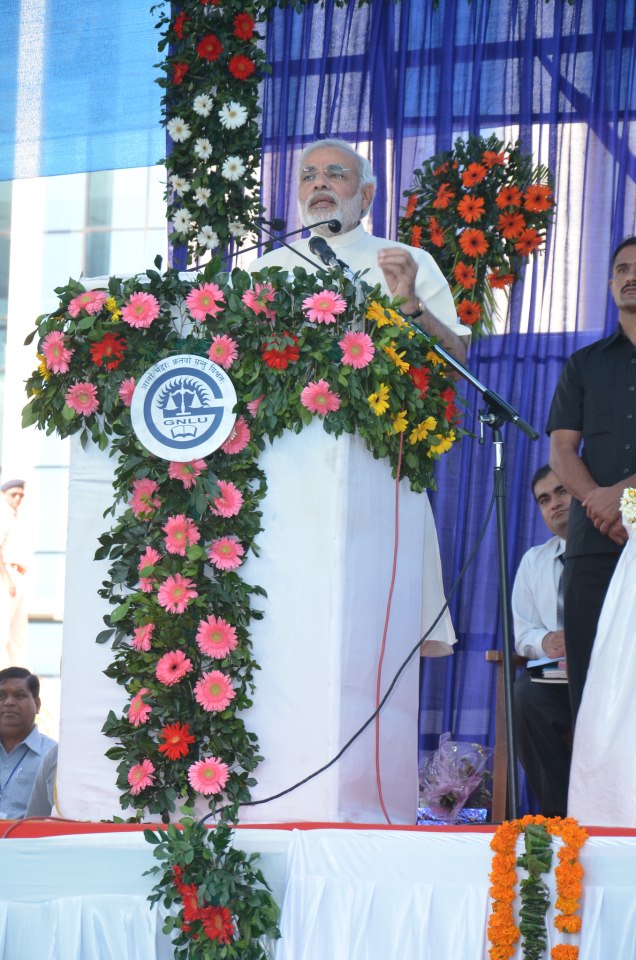
Modi addressing graduates of the Gujarat National Law University in 2012.
During the 2012 campaign, Modi attempted to identify himself with the state of Gujarat, a strategy similar to that used by Indira Gandhi during the Emergency, and projected himself as protecting Gujarat against persecution by the rest of India.
Despite the BJP's shift away from explicit Hindutva, Modi's election campaign in 2007 and 2012 contained elements of Hindu nationalism.
Modi only attended Hindu religious ceremonies, and had prominent associations with Hindu religious leaders.
During his 2012 campaign he twice refused to wear articles of clothing gifted by Muslim leaders.
[-1] He did, however, maintain relations with Dawoodi Bohra. [-1] His campaign included references to issues known to cause religious polarisation, including to Afzal Guru and the killing of Sohrabuddin Sheikh. The BJP did not nominate any Muslim candidates for the assembly election of 2012. [-1] He had published a Gujarati book titled Jyotipunj in 2008, containing profiles of various RSS leaders. The longest was of M. S. Golwalkar, under whose leadership the RSS expanded and whom Modi refers to as Pujniya Shri Guruji ("Guru worthy of worship"). [352] According to *The Economic Times *, his intention was to explain the workings of the RSS to his readers and to reassure RSS members that he remained ideologically aligned with them. Modi authored eight other books, mostly containing short stories for children. [415]
While campaigning for the 2012 assembly elections, Modi made extensive use of holograms and other technologies allowing him to reach a large number of people, something he would repeat in the 2014 general election.
In the 2012 Gujarat Legislative Assembly elections, Modi won the constituency of Maninagar by 86,373 votes over Shweta Bhatt, the INC candidate and wife of Sanjiv Bhatt. [47] The BJP won 115 of the 182 seats, continuing its majority during his tenure [172] and allowing the party to form the government (as it had in Gujarat since 1995). [423] In later by-elections the BJP won four more assembly seats and two Lok Sabha seats held by the INC, although Modi did not campaign for its candidates. [218] In 2013, the Wharton India Economic Forum (WIEF) at the Wharton School of the University of Pennsylvania cancelled a keynote video-conference speech by Modi following protests by Indian-Americans. [218] After his election as prime minister, Modi resigned as the chief minister and as an MLA from Maninagar on 21 May 2014. Anandiben Patel succeeded him as the chief minister. [218]
2014 Indian general election
In September 2013 Modi was named the BJP's candidate for prime minister in the 2014 Lok Sabha election.
[-1] [218] Several BJP leaders expressed opposition to Modi's candidature, [-1] including BJP founding member L. K. Advani, who cited concern with leaders who were "concerned with their personal agendas". [218] Modi played a dominant role in the BJP's election campaign. [218] [-1] Several people who voted for the BJP stated that if Modi had not been the prime-ministerial candidate, they would have voted for another party. [-1] [-1] The focus on Modi as an individual was unusual for a BJP election campaign. [-1] The election was described as a referendum on Narendra Modi.
During the campaign, Modi focused on the corruption scandals under the previous INC government, and played on his image as a politician who had created a high rate of GDP growth in Gujarat.
[-1] Modi projected himself as a person who could bring about "development," without focus on any specific policies.
[-1] His message found support among young Indians and among middle-class citizens.
The BJP under Modi was able to downplay concerns about the protection of religious minorities and Modi's commitment to secularism, areas in which he had previously received criticism. Prior to the election Modi's image in the media had centered around his role in the 2002 Gujarat riots, but during the campaign the BJP was able to shift this to a focus on Modi's neoliberal ideology and the Gujarat model of development. [-1] Although the BJP avoided issues of Hindu nationalism to an extent, Hindutva remained a significant part of its campaign. [-1] The BJP's campaign was assisted by its wide influence in the media. [-1] Modi's campaign blitz cost approximately ₹50 billion (US$780 million), and received extensive financial support from corporate donors. [-1] In addition to more conventional campaign methods, Modi made extensive use of social media, [-1] and addressed more than 1000 rallies via hologram appearances.
The BJP won 31% of the vote, and more than doubled its tally in the Lok Sabha to 282, becoming the first party to win a majority of seats on its own since 1984. [-1] Voter dissatisfaction with the INC, as well as with regional parties in North India, was another reason for the success of the BJP, as was the support from the RSS. [-1] In states such as Uttar Pradesh in which the BJP performed well, it drew exceptionally high support from upper-caste Hindus, although the 10 percent of Muslim votes won was more than it had won before. It performed particularly well in parts of the country that had recently experienced violence between Hindus and Muslims. The magnitude of the BJP's victory led many commentators to say that the election constituted a political realignment away from progressive parties and towards the right-wing. Modi's tweet announcing his victory was described as being emblematic of the political realignment away from a secular, socialist state towards capitalism and Hindu cultural nationalism. [-1]
Modi himself was a candidate for the Lok Sabha in two constituencies: Varanasi and Vadodara. [221] He won in both constituencies, defeating Aam Aadmi Party leader Arvind Kejriwal in Varanasi and Madhusudan Mistry of the INC in Vadodara by 570,128 votes. [339] Modi, who was unanimously elected leader of the BJP, was appointed prime minister by India's president. [430] [79] To comply with the law that an MP cannot represent more than one constituency, he vacated the Vadodara seat. [209]
Prime Minister
Modi was sworn in as the Prime Minister of India on 26 May 2014 at the Rashtrapati Bhavan. He became the first Prime Minister born after India's independence from the British Empire. [355] His first cabinet consisted of 45 ministers, 25 fewer than the previous United Progressive Alliance (UPA) government. [33] 21 new ministers were added to the council of ministers in November 2014. [-1] During his premiership, India rose to the 100th rank in the 2018 Ease of Doing Business ranking by World Bank. [369]
Economic policies
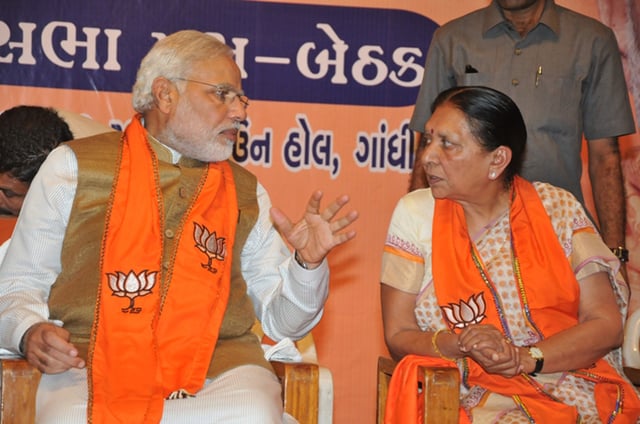
Modi with Anandiben Patel at a meeting of BJP MLAs after his election as prime minister; Patel succeeded him as Gujarat chief minister.
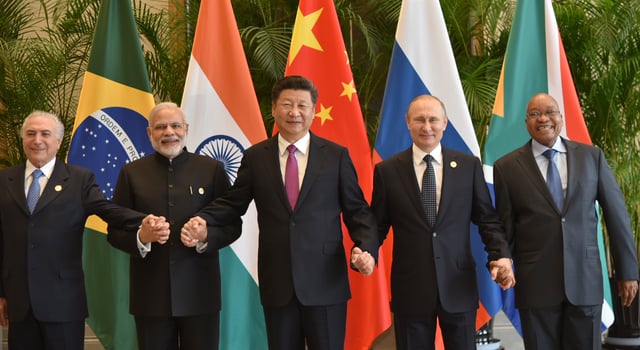
Modi with other BRICS leaders in 2016.
The economic policies of Modi's government focused on privatisation and liberalisation of the economy, based on a neoliberal framework. [-1] Modi liberalised India's foreign direct investment policies, allowing more foreign investment in several industries, including in defence and the railways. [-1] [437] [104] Other reforms included removing many of the country's labour laws, to make it harder for workers to form unions and easier for employers to hire and fire them. These reforms met with support from institutions such as the World Bank, but opposition from scholars within the country. The labour laws also drew strong opposition from unions: on 2 September 2015, eleven of the country's largest unions went on strike, including one affiliated with the BJP. The Bharatiya Mazdoor Sangh, a constituent of the Sangh Parivar, stated that the reforms would hurt labourers by making it easier for corporations to exploit them. [-1] In his first budget, Finance Minister Arun Jaitley promised to gradually reduce the budgetary deficit from 4.1 percent to 3 percent over two years, and to divest from shares in public banks. [-1] Over Modi's first year in office, the Indian GDP grew at a rate of 7.5 percent, making it the world's fastest-growing large economy.
The funds dedicated to poverty reduction programmes and social welfare measures were greatly decreased by the Modi administration.
[-1] The money spent on social programmes declined from 14.6% of GDP during the Congress government to 12.6% during Modi's first year in office.
[-1] Spending on health and family welfare declined by 15%, and on primary and secondary education by 16%.
[-1] The budgetary allocation for the Sarva Shiksha Abhiyan, or the "education for all" programme, declined by 22%. [-1] The government also lowered corporate taxes, abolished the wealth tax, and reduced customs duties on gold, jewelry, and increased sales taxes. [-1] In October 2014, the Modi government deregulated diesel prices, [195] and later increased taxes on diesel and petrol. [-1]
In September 2014, Modi introduced the Make in India initiative to encourage foreign companies to manufacture products in India, with the goal of turning the country into a global manufacturing hub. [-1] [333] Supporters of economic liberalisation supported the initiative, while critics argued it would allow foreign corporations to capture a greater share of the Indian market. [-1] In order to enable the construction of private industrial corridors, the Modi administration passed a land-reform bill that allowed it to acquire private agricultural land without conducting a social impact assessment, and without the consent of the farmers who owned it. Under the previous bill, the government had required the consent of 80% of the owners of a piece of property before acquiring it for a private project: this requirement was waived. [-1] The bill was passed via an executive order after it faced opposition in parliament, but was eventually allowed to lapse. [-1] Modi's government put in place the Goods and Services Tax, the biggest tax reform in the country since independence. It subsumed around 17 different taxes and became effective from 1 July 2017.
On 25 June 2015, Modi launched a programme intended to develop 100 smart cities. [142] The "Smart Cities" programme is expected to bring Information Technology companies an extra benefit of ₹20 billion (US$310 million). [242] In June 2015, Modi launched the "Housing for All By 2022" project, which intends to eliminate slums in India by building about 20 million affordable homes for India's urban poor. [379]
In his first cabinet decision, Modi set up a team to investigate black money. [41] On 9 November 2016, the government demonetised ₹500 and ₹1000 banknotes, with the stated intention of curbing corruption, black money, the use of counterfeit currency, and terrorism. [150] The move led to widespread protests throughout the country, including one by opposition parties, which stalled the winter session of parliament. [272] In the days following the demonetisation, banks across the country faced severe cash shortages, [392] [67] [128] which had detrimental effects on a number of small businesses, on agriculture, and on transportation. People seeking to exchange their notes had lengthy waits, and several deaths were linked to the rush to exchange cash. [253] [384] Following Modi's announcement, the Indian stock indices BSE SENSEX and NIFTY 50 declined steeply. [70] There has been a steep increase in digital payments and transactions in the country since the day demonetization was announced. [181] Post the demonetisation, the quantum of income tax returns filed for individuals jumped by 25% indicating the widened tax net. Further, the advance tax collections rose by 42% and Self assessment tax collections rose by 34.25%. [341]
Health and sanitation policies
In his first year as prime minister, Modi reduced the amount of money spent by the government on healthcare.
[338] The Modi government launched a "New Health Policy" in January 2015, although this did not increase the government's spending on healthcare, instead emphasizing the role of private healthcare organisations.
This represented a shift away from the policy of the previous Congress government, which had supported programmes to assist public health goals, including reducing child and maternal mortality rates.
The National Health Mission, which included public health programmes targeted at these indices received nearly 25% less funds in 2015 than in the previous year.
15 national health programmes, including those aimed at controlling tobacco use and supporting healthcare for the elderly, were merged with the National Health Mission, and received less funds than in previous years.
Modi initially appointed Harsh Vardhan, a doctor and an advocate of tobacco control, as minister of health. However, Vardhan was removed in November 2015. The government introduced stricter packaging laws for tobacco which requires 85% of the packet size to be covered by pictorial warnings. [44] In its budget for the second year after it took office, the Modi government reduced healthcare spending by 15%. Modi has generally emphasised his government's efforts at sanitation as a means of ensuring good health. An article in the medical journal *Lancet * stated that the country "might have taken a few steps back in public health" under Modi.
On 2 October 2014, Modi launched the Swachh Bharat Abhiyan ("Clean India") campaign. The stated goals of the campaign included eliminating open defecation and manual scavenging. [-1] The plan was to achieve these aims in five years. [-1] As part of the programme, the Indian government began constructing millions of toilets in rural areas and encouraging people to use them. [309] [31] [140] The government also announced plans to build new sewage treatment plants. [140] The administration plans to construct 60 million toilets by 2019. The construction projects have faced allegations of corruption, and have faced severe difficulty in getting people to use the toilets constructed for them. [-1] [309] [31]
Hindutva and education policy
During the 2014 election campaign, the BJP sought to identify itself with political leaders known to have opposed Hindu nationalism, including B. R. Ambedkar, Subhas Chandra Bose, and Ram Manohar Lohia. [-1] The campaign also saw the use of rhetoric based on Hindutva, however, by BJP leaders in certain states. [-1] Communal tensions were played upon especially in Uttar Pradesh and the states of Northeast India. [-1] A proposal for the controversial Uniform Civil Code was a part of the BJP's election manifesto.
Several state governments headed by the BJP have enacted policies aligned with Hindutva after the election of Modi as prime minister.
The government of Maharashtra banned the killing of cows in 2014.
[-1] The Modi administration has generally avoided directly supporting policies related to a Hindutva agenda.
[-1] There has been an increase in the activities of a number of other Hindu nationalist organisations, sometimes with the support of the government.
[-1] [-1] The incidents included a Hindu religious conversion programme, a campaign against the alleged Islamic practice of "Love Jihad", and attempts to celebrate Nathuram Godse, the assassin of Mahatma Gandhi, by members of the right wing Hindu Mahasabha. [-1] The attempts at religious conversion have been described by the VHP and other organisations involved with them as attempts at "reconversion" from Islam or Christianity. There have been a number of reports of intimidation or coercion of the subjects during these attempts. [-1] Officials in the government, including the Home Minister, have defended the attempts. [-1] There were additional incidents of violence targeted at religious minorities by Hindu nationalists. [-1] Modi refused to remove a government minister from her position after a popular outcry resulted from her referring to religious minorities as "bastards." [-1] Commentators have suggested, however, that the violence was perpetrated by radical Hindu nationalists to undercut the authority of Modi. [-1]
The Modi administration appointed Yellapragada Sudershan Rao, who had previously been associated with the RSS, chairperson of the Indian Council of Historical Research (ICHR). In reaction to his appointment, other historians and former members of the ICHR, including those sympathetic to the ruling party, questioned his credentials as a historian. Several stated that the appointment was part of an agenda of cultural nationalism. [102] [206]
The government began formulating a New Education Policy, or NEP, soon after its election.
As of March 2016, this policy had yet to be implemented.
This was the third education policy introduced by the Indian government, following those of 1968 and 1986.
The policy was described as having overtones of Hindutva.
The RSS had a role in its creation, and it did not explicitly mention the goals of "socialism, secularism and democracy" that had been mentioned in the first two policies.
The policy emphasised the education of minority students, as well as those of economically backward groups, in particular on improving enrolment in schools among those groups.
The policy proposed bringing religious educational institutions under the Right to Education Act. There was also a debate about removing caste-based reservation in favour of reservation based on income, a move supported by the RSS, but which was criticised as being discriminatory on the basis of caste. [-1]
Foreign policy
Foreign policy played a relatively small role in Modi's election campaign, and did not feature prominently in the BJP's election manifesto.
[-1] Modi invited all the other leaders of SAARC countries to his swearing in ceremony as prime minister. [-1] [-1] He was the first Indian prime minister to do so. [244]
Modi's foreign policy, similarly to that of the preceding INC government, focused on improving economic ties, security, and regional relations.
[-1] Modi continued Manmohan Singh's policy of "multi-alignment."
[-1] The Modi administration tried to attract foreign investment in the Indian economy from several sources, especially in East Asia, with the use of slogans such as "Make in India" and "Digital India".
[-1] As a part of this policy, the Modi government completed India's application to join the Shanghai Cooperation Organisation, which is led by China and Russia. (SCO). [-1] The government also tried to improve relations with Islamic nations in the Middle East, such as Bahrain, Iran, Saudi Arabia, and the United Arab Emirates, as well as with Israel. [-1] Modi added five bilateral strategic partnerships to the 25 that had been agreed by his predecessors Singh and Vajpayee. [-1]
During the first few months after the election, Modi made trips to a number of different countries to further the goals of his policy, and attended the BRICS, ASEAN, and G20 summits. [-1] One of Modi's first visits as prime minister was to Nepal, during which he promised a billion USD in aid. [-1] Modi also made several overtures to the United States, including multiple visits to that country. [-1] While this was described as an unexpected development, due to the US having previously denied Modi a travel visa over his role during the 2002 Gujarat riots, it was also expected to strengthen diplomatic and trade relations between the two countries. [-1]
In 2015, the Indian parliament ratified a land exchange deal with Bangladesh about the India–Bangladesh enclaves, which had been initiated by the government of Manmohan Singh. [-1] Modi's administration gave renewed attention to India's "Look East Policy", instituted in 1991. The policy was renamed the "Act East Policy", and involved directing Indian foreign policy towards East Asia and Southeast Asia. [-1] The government signed agreements to improve land connectivity with Myanmar, through the state of Manipur. This represented a break with India's historic engagement with Myanmar, which prioritised border security over trade. As of July 2016, Modi had made 51 trips to 42 countries with the intent of strengthening diplomatic relations. [244] [244]
Defence policy
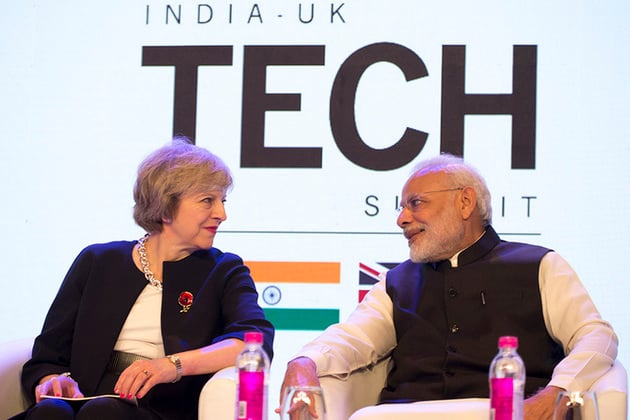
Modi and British Prime Minister Theresa May at the India-UK Tech Summit in New Delhi
The BJP election manifesto had also promised to deal with illegal immigration into India in the Northeast, as well as to be more firm in its handling of insurgent groups.
During the election campaign, Modi said that he would be willing to accommodate Hindu migrants who were being persecuted in Bangladesh, but those that came with "political objectives" would have to be sent back.
The Modi government issued a notification allowing Hindu, Sikh, and Buddhist illegal immigrants from Pakistan and Bangladesh to legalise their residency in India.
The government described the measure as being taken for humanitarian reasons but it drew criticism from several Assamese organisations.
The Modi administration negotiated a peace agreement with the largest faction of the National Socialist Council of Nagaland (NSCM), which was announced in August 2015. The Naga insurgency in northwest India had begun in the 1950s. [-1] [277] The NSCM and the government had agreed to a ceasefire in 1997, but a peace accord had not previously been signed. [277] In 2015 the government abrogated a 15-year ceasefire with the Khaplang faction of the NSCM (NSCM-K). The NSCM-K responded with a series of attacks, which killed 18 people. [-1] The Modi government carried out a raid across the border with Myanmar as a result, and labelled the NSCM-K a terrorist organisation. [-1]
Modi has repeatedly stated that Pakistan was an exporter of terrorism. [11] [380] On 29 September 2016, the Indian Army stated that it had conducted a surgical strike on terror launchpads in Azad Kashmir, [380] although Pakistan denied the claim, and the details of the confrontation are still in dispute. [380] [1]
Environmental policies
In naming his cabinet, Modi renamed the "Ministry of Environment and Forests" the "Ministry of Environment, Forests, and Climate Change."
In the first budget of the government, the money allotted to this ministry was reduced by more than 50%.
The new ministry also removed or diluted a number of laws related to environmental protection.
These included no longer requiring clearance from the National Board for Wildlife for projects close to protected areas, and allowing certain projects to proceed before environmental clearance was received. [-1] The government also tried to reconstitute the Wildlife board such that it no longer had representatives from non-governmental organisations: however, this move was prevented by the Supreme Court.
Modi also relaxed or abolished a number of other environmental regulations, particularly those related to industrial activity.
A government committee stated that the existing system only served to create corruption, and that the government should instead rely on the owners of industries to voluntarily inform the government about the pollution they were creating.
[-1] Other changes included reducing ministry oversight on small mining projects, and no longer requiring approval from tribal councils for projects inside forested areas.
In addition, Modi lifted a moratorium on new industrial activity in the most polluted areas in the countries.
The changes were welcomed by businesspeople, but criticised by environmentalists.
Under the UPA government that preceded Modi's administration, field trials of Genetically Modified (GM) crops had essentially been put on hold, after protests from farmers fearing for their livelihoods. Under the Modi government these restrictions were gradually lifted. The government received some criticism for freezing the bank accounts of environmental group Greenpeace, citing financial irregularities, although a leaked government report said that the freeze had to do with Greenpeace's opposition to GM crops.
Governance and other initiatives
Modi's first year as prime minister saw significant centralisation of power relative to previous administrations.
[-1] [-1] Modi's efforts at centralisation have been linked to an increase in the number of senior administration officials resigning their positions. [-1] Although the government has a majority of seats in the Lok Sabha, it does not have one in the Rajya Sabha, which led to its policies frequently being stymied there. Thus, Modi resorted to passing a number of ordinances to enact his policies, leading to further centralisation of power. [-1] The government also passed a bill increasing the control that it had over the appointment of judges, and reducing that of the judiciary.
On 31 December 2014, Modi announced that the Planning Commission had been scrapped. It was replaced with a body called the National Institution for Transforming India, or NITI Aayog. [297] [-1] The Planning Commission was a legacy of the Indian Independence movement, although critics said that it was slowing economic growth. The move had the effect of greatly centralising the power previously with the planning commission in the person of the prime minister. [-1] [-1] [297] [-1] It also reduced the extent of control individual states had over their financial allocation from the union government, [-1] and unlike the planning commission, it does not have the power to allocate funds. [-1] The planning commission had received heavy criticism in previous years for creating inefficiency in the government, and of not filling its role of improving social welfare: however, since the economic liberalisation of the 1990s, it had been the major government body responsible for measures related to social justice. [-1]
The Modi government launched a crackdown against a number of civil society organisations.
Several tens of thousands of organisations were investigated by the Intelligence Bureau in the first year of the administration, on the grounds that they were slowing economic growth. International humanitarian aid organisation Medecins Sans Frontieres was among the groups that were put under pressure. [-1] Other organisations affected included the Sierra Club and Avaaz. [-1] Cases of sedition were filed against individuals criticising the government. [-1] This led to discontent within the BJP regarding Modi's style of functioning and drew comparisons to the governing style of Indira Gandhi. [-1] [-1]
Modi repealed 1,200 obsolete laws in first three years as prime minister, against a total of 1,301 such laws repealed by previous governments over a span of 64 years.
[182] [243] [376] He started a monthly radio programme titled "Mann Ki Baat" on 3 October 2014. [48] Modi also launched the Digital India programme, which has the goal of ensuring that government services are available electronically, building infrastructure to provide high-speed Internet access to rural areas, boosting manufacturing of electronic goods in the country, and promoting digital literacy. [168] [287]
Personal life and image
Personal life
In accordance with Ghanchi tradition, Modi's marriage was arranged by his parents when he was a child.
He was engaged at age 13 to Jashodaben, marrying her when he was 18. They spent little time together and grew apart when Modi began two years of travel, including visits to Hindu ashrams. [17] [422] Reportedly, their marriage was never consummated, and he kept it a secret because otherwise he could not have become a 'pracharak' in the puritan Rashtriya Swayamsewak Sangh. [361] Although Modi kept his marriage secret for most of his career, he acknowledged his wife when he filed his nomination for a parliamentary seat in the 2014 general elections. [109] [109] Modi maintains a close relationship with his mother, Hiraben and often visits her on his birthday to seek her blessings. [109]
A vegetarian, [109] Modi has a frugal lifestyle and is a workaholic and introvert. [109] Adept at using social media, he has been since September 2014 the second-most-followed leader in the world (with over 34.6 million followers on Twitter as of September 2017), behind Barack Obama (95.6 million followers) and Donald Trump(3 8.8 million followers). [210] [109] Modi's 31 August 2012 post on Google Hangouts made him the first Indian politician to interact with netizens on live chat. [386] [84] Modi has also been called a fashion-icon for his signature crisply ironed, half-sleeved *kurta *, as well as for a suit with his name embroidered repeatedly in the pinstripes that he wore during a state visit by US President Barack Obama, which drew public and media attention and criticism. [250] [436] Modi's personality has been variously described by scholars and biographers as energetic, arrogant, and charismatic.
The nomination of Modi for the prime ministership drew attention to his reputation as "one of contemporary India's most controversial and divisive politicians."
[240] [240] [240] During the 2014 election campaign the BJP projected an image of Modi as a strong, masculine leader, who would be able to take difficult decisions. [-1] [-1] [-1] Campaigns in which he has participated have focused on Modi as an individual, in a manner unusual for the BJP and RSS. [-1] Modi has relied upon his reputation as a politician able to bring about economic growth and "development". [86] Nonetheless, his role in the 2002 Gujarat riots continues to attract criticism and controversy. [411] Modi's hardline Hindutva philosophy and the policies adopted by his government continue to draw criticism, and have been seen as evidence of a majoritarian and exclusionary social agenda. [411] [-1] [-1]
Approval ratings
As a Prime Minister, Modi has received consistently high approval ratings; at the end of his first year in office, he received an overall approval rating of 87% in a Pew Research poll, with 68% of people rating him "very favorably" and 93% approving of his government.
[240] His approval rating remained largely consistent at around 74% through his second year in office, according to a nationwide poll conducted by instaVaani.
[240] At the end of his second year in office, an updated Pew Research poll showed Modi continued to receive high overall approval ratings of 81%, with 57% of those polled rating him "very favorably."
[360] [360] At the end of his third year in office, a further Pew Research poll showed Modi with an overall approval rating of 88%, his highest yet, with 69% of people polled rating him "very favorably." [360] A poll conducted by The Times of India in May 2017 showed 77% of the respondents rated Modi as "very good" and "good". [360] In early 2017, a survey from Pew Research Center showed Modi to be the most popular figure in Indian politics. [360]
Awards and recognition
Modi was named the Best Chief Minister in a 2007 nationwide survey by *India Today *. [360] In March 2012, he appeared on the cover of the Asian edition of *Time Magazine *, one of the few Indian politicians to have done so. [360] He was awarded Indian of the Year by *CNN-IBN * news network in 2014. [360] In 2014, 2015 and 2017, he was named one of Time magazine's 100 Most Influential People in the World. [360] [360] [269] He was also declared winner of the Time magazine reader's poll for Person of the Year in 2014 and as well as in 2016. [404] [68] *Forbes Magazine * ranked him the 15th-Most-Powerful Person in the World in 2014 and the 9th-Most-Powerful Person in the World in 2015 and 2016. [179] [346] [9] [99] In 2015, Modi was ranked the 13th-Most-Influential Person in the World by *Bloomberg Markets Magazine *. [227] In the same year he was named one of Time' s "30 Most Influential People on the Internet" as the second-most-followed politician on Twitter and Facebook. [354] Modi was ranked fifth on *Fortune Magazine *' s first annual list of the "World's Greatest Leaders" in 2015. [5] [123] In 2016, a wax statue of Modi was unveiled at Madame Tussaud Wax Museum in London. [259] [396]
State honours
| Decoration | Country | Date | Note | Ref. | ||
|---|---|---|---|---|---|---|
| **Order of Abdulaziz al Saud ** | [[INLINE_IMAGE|https://upload.wikimedia.org/wikipedia/commons/thumb/0/0d/Flag_of_Saudi_Arabia.svg/23px-Flag_of_Saudi_Arabia.svg.png|||h15|w23|thumbborder]]Saudi Arabia | 3 April 2016 | Member Special Class, The highest civilian honor of Saudi Arabia | [57] | |
| **State Order of Ghazi Amir Amanullah Khan ** | [[INLINE_IMAGE|https://upload.wikimedia.org/wikipedia/commons/thumb/9/9a/Flag_of_Afghanistan.svg/23px-Flag_of_Afghanistan.svg.png|||h15|w23|thumbborder]]Afghanistan | 4 June 2016 | The highest civilian honor of Afghanistan | [174] | |
====THE CONTENT BELOW WAS MERGED IN FROM [/lang_en/narendramodi]====
Narendra Damodardas Modi is the 15th and current Prime Minister of India, in office since 26 May 2014. Modi, a leader of the Bharatiya Janata Party(BJP), was the Chief Minister of Gujarat from 2001 to 2014 and is the Member of Parliament from Varanasi.
The BJP party pays lip service to reducing the yawning inequalities that disfigure India, but political cleavages in India’s party system have grown along the lines of caste and religious conflict.
This suits the BJP, with its pro-business and anti-Muslim nationalism.

